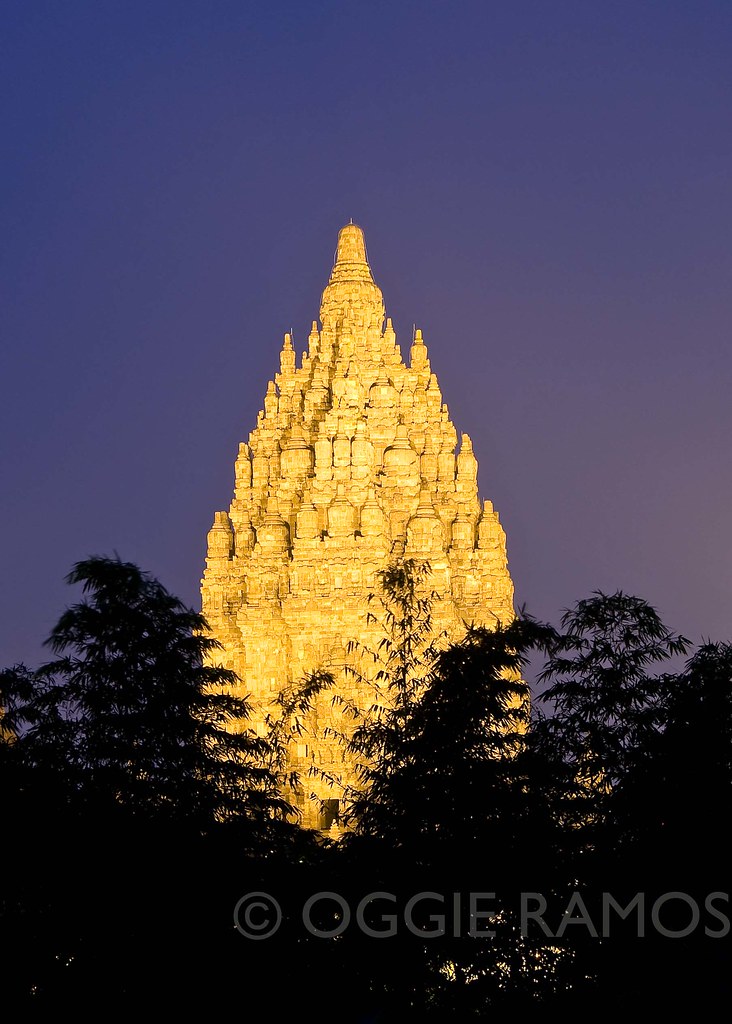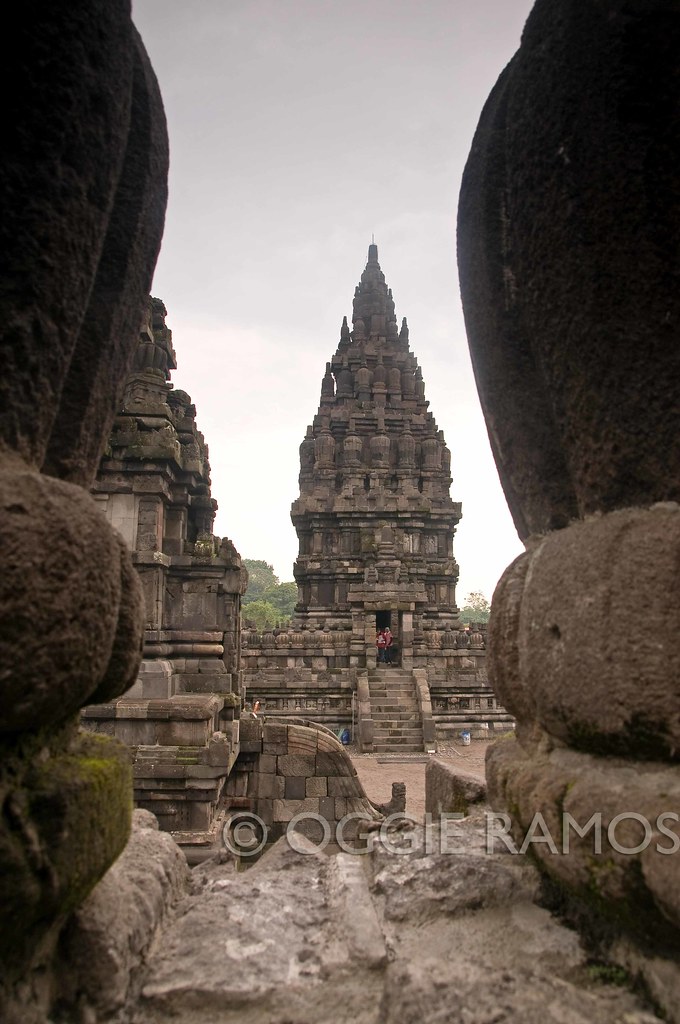 |
| Prambanan Shiva Temple at night |
To visitors of Central Java (or Indonesia, for that matter), Prambanan is a must-visit. The complex is located 18 kilometers east of Jogja, a veritable quilt of temples and shrines dating back to the 8th and 9th centuries spread over 30 square kilometers. From a distance, three giant temples stand out as if reaching upwards to the darkening sky in a complex so vast (the largest of its kind in all of Java), it rivals Borobudur. Even the most culturally-bereft or disinterested will find it hard to miss the grandeur of this UNESCO Heritage Site.
 |
| A view of the Hamsa Shrine from the shrine dedicated to Brahma, the Creator |
A short take on a long and colorful history. The building of the Hindu temple signified a shift from Mahayana Buddhism to Shivaist Hinduism as suggested by historians when the Hindu Sanjaya dynasty returned to power after nearly a hundred years under the Buddhist Sailendra. The first temples date back to 832 AD, built in answer to the nearby Buddhist temples of Borobudur and Candi Sewu. The temple was originally named Shiva-grha or house of Shiva. The compound was expanded by Mataram kings, Prambanan being the royal temple of the Hindu kingdom of Mataram. It was subsequently abandoned perhaps due to the eruption of Mt. Merapi and the temples collapsed in the 16th century due to a major earthquake.
 |
| Woman inside one of the shrines |
Prambanan was rediscovered in 1811 during the rule of the Dutch East Indies but it would be more than a hundred years later when reconstruction commenced. Only the foundations of the smaller shrines remained and so were left in ruins. The reconstruction of the main temples were completed in the 1990s, only to suffer significant damage in 2006. The temple at the very center (the shrine dedicated to Shiva) was off-limits to visitors when we visited and we have to content ourselves in admiring it from afar. Hmmm, at least, we were able to enter the central compound, considered the holiest among the three zones, and admire the other two main shrines that compose the Trimurti (three forms) which are dedicated to Brahma (the Creator) located eastward and Vishnu (the Keeper) located northwards as well as the smaller ones on the elevated platform which are dedicated to the vehicles of the gods (Nandi, the bull for Shiva, Hamsa, the swan for Brahma and Garuda, the eagle, for Vishnu).
 |
| The three main shrines shine even after dusk settles in over the plain |
Prambanan after dark. With the rains letting up before dark, we were hoping for a glimpse of a decent sunset but 5:30 came and went with no hint of one. A kind guide accompanying American visitors clued us in to the open air restaurant on the other side of the Opak river where we can hopefully catch the three main shrines lit for the evening. The sight was edifying, a perfect treat to our first afternoon in Central Java and a prelude to watching the Ramayana Ballet performance in the nearby open air theater.
Notes: The entrance fee to Prambanan normally goes for up to Rp130,000 (approximately P625 or US$14) but we were able to get ours for Rp110,000 (P550 or US$12), thanks to our guide, Uki • I highly recommend Ukhi (Tukijo Adi-Wiyono) as a guide and driver for his work ethic, resourcefulness and hospitality (also good value for money); contact him via email at [email protected]
 Alternative ways of going to Prambanan: via bus, go to the Giwangan bus station just inside the city ring road or join all-inclusive tours offered by several operators • References: Wikipedia • Rough Guides to Southeast Asia on a Budget; www.roughguides.com •
Alternative ways of going to Prambanan: via bus, go to the Giwangan bus station just inside the city ring road or join all-inclusive tours offered by several operators • References: Wikipedia • Rough Guides to Southeast Asia on a Budget; www.roughguides.com •
 Alternative ways of going to Prambanan: via bus, go to the Giwangan bus station just inside the city ring road or join all-inclusive tours offered by several operators • References: Wikipedia • Rough Guides to Southeast Asia on a Budget; www.roughguides.com •
Alternative ways of going to Prambanan: via bus, go to the Giwangan bus station just inside the city ring road or join all-inclusive tours offered by several operators • References: Wikipedia • Rough Guides to Southeast Asia on a Budget; www.roughguides.com • Next in Lagalog's 7-Part Series on Indonesia:
Part 3 -- A Tale of Two Ramayanas
Part 3 -- A Tale of Two Ramayanas
